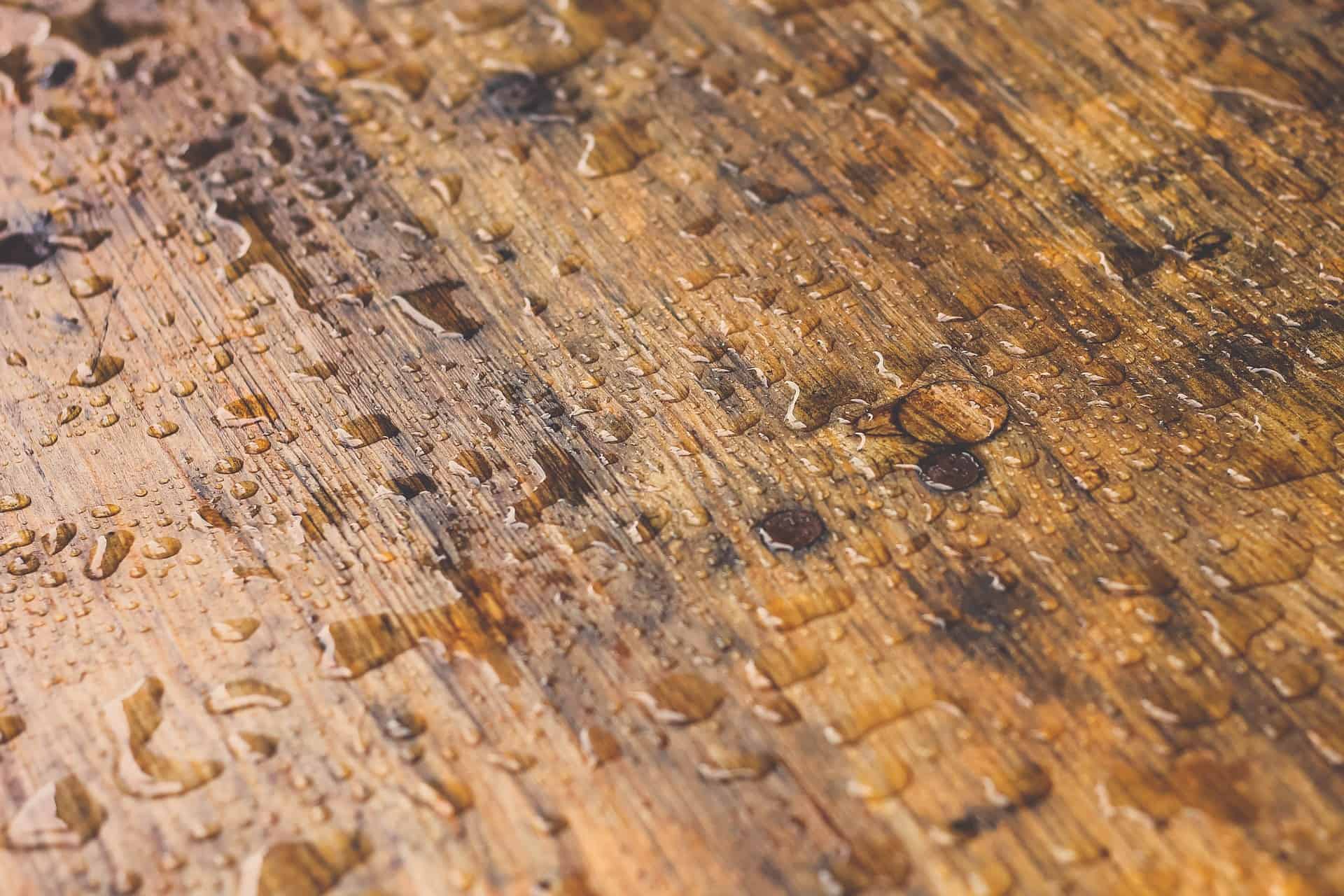This post contains affiliate links.
Engineered woods are more dimensionally stable than solid hardwoods. It means that engineered woods hold its shape better under moisture exposure better than solid hardwoods. This also means that engineered wood floors, unlike solid hardwood floors, can be installed in areas that are susceptible to moderate moisture exposure just like in basements.
But with any wood products, engineered hardwoods will still be damaged when exposed to moisture for too long. And so this leads to the question of can engineered wood floors get wet?
Most engineered wood floors can get wet and are water-resistant but to a certain degree. Liquid spilled on the engineered wood floors should ideally be wiped dry immediately or at the latest within 2-3 hours. Damage can occur when water gets into the cracks and joints and soak the floor’s core.
Although engineered wood floors can still get water damage despite it being more water-resistant as compared to solid hardwood floors, there are many ways to mitigate the effects of water and moisture and prolong the lifespan of the floor.
Engineered Wood Floors are Water-Resistant but are not 100% Water-Proof
Just like solid hardwood floors, there are no 100% water-proof engineered wood floors. Both can be water-resistant to a certain degree. Organic materials such as wood, when subjected to moisture can start decomposing and attract a variety of molds and bacteria. Wood materials are made water-resistant by adding protective layers and coatings or mixing by mixing them with resin or other chemicals to resist the effects of water.
Both solid hardwood and engineered wood floors have a real solid wood outside face, the only difference is the construction of their core. If a solid hardwood floor plank has only one and the same material all throughout, face and core, an engineered wood floor plank is composed of several layers composing of a solid wood top face and a multi-layered core.
The top layer of most engineered wood floors is finished with a water-resistant coating that will prevent water from sipping through the surface. Although each manufacturer will have their own set of specifications with regards to the amount of time that their products can resist liquid spills, it is ideally best to wipe off the liquid as soon as it happens, or at the latest 2-3 hours after.
The floor’s top coating is good at resisting water initially but letting the liquid stand for some time will allow the liquid to spread and look for any cracks or joints it can enter. As soon as the liquid gets inside to the core, that’s where you get into trouble. The core of most engineered wood floors is not water-resistant and will be damaged if it gets soaked in water. As soon as enough water is absorbed by the core, the floor will start to expand and cupping or buckling will happen.
Most engineered wood floors have a plywood core composing of 3 or more wood veneers that are glued together with the grains of each veneer arranged at alternating 90 degrees directions of each other. This makes engineered wood floors more dimensionally stable than solid hardwood floors. This means that unlike solid hardwood floors that shrink or swell as the humidity of its environment goes up or down, engineered wood floors resist changes in its form.
Also, being dimensionally stable, engineered wood floors won’t create gaps or cracks if humidity is low, which prevents standing water from getting into its core easily. This is a completely opposite situation from solid hardwood floors that will have those open gaps in their joints when humidity becomes low. This is one of the reasons why engineered wood floors are superior to solid hardwood floors.
Engineered Floors Can Be Installed in Damp Areas
Because of the engineered wood floor’s high dimensional stability as compared to solid hardwood floors, they can be installed in areas that are damp such as in basements or below grades. Areas that are below grade tend to become damp and humid because of the moisture from the soil pushes itself inside through the small pores of the concrete walls and floor.
Although engineered wood floors can withstand the high levels of humidity such as in basements, it still is best to try to mitigate or control the moisture levels in the air and in the subfloor’s surface.
One such solution to prevent water from entering through the floor or walls from the outside is by installing a vapor barrier or applying a waterproofing system that is applicable to the affected area. Dehumidifiers will also help control the levels of humidity in the area.
Never Clean Engineered Wood Floors with a Wet Mop
One of the biggest mistakes that people make when cleaning engineered wood floors is cleaning the floor with a wet mop. Unlike other solid floors that are cleaned with a bucket of cleaning solution and a wet mop, engineered wood floors can get damaged if subjected to this method of cleaning.
Though engineered wood floors are water-resistant, the volume of water a wet mop holds is big enough to create areas on the floor with standing water. The constant pushing and pulling action of the wet mop against the engineered wood floors may also allow water to seep inside the joints of the floor into the core and cause irreparable damage.
Most manufacturers recommend cleaning engineered wood floors with a damp mop or cloth instead. Or using a sprayed cleaning solution, made specifically for engineered wood floors, and wiped with a damp mop or a flathead microfiber mop.
Common Causes of Water Damage to Engineered Wood Floors to Watch Out For
Water damage on engineered wood floors can come from several sources and here are some of the common ones to watch out for:
A. Water under the floor
Subfloor moisture can come from groundwater intrusions especially if the room you’ve installed the engineered wood floors is below ground, or in a basement area.
Another possible source of water can come from busted water pipes or leaking appliances. Make sure that all pipes and furniture with water lines are free from leaks to avoid damaging your wood floors.
B. High Humidity in the Room
Although engineered wood floors were designed to withstand any dimensional changes, unusually high humidity can still affect the flooring and can damage it if not addressed in time.
High humidity usually happens in areas below ground or in basements. Check if there are any leaks or any moisture getting through the walls or the floors. You might also consider installing dehumidifiers to mitigate the amount of moisture in the air.
C. Improper Acclimation
Just like any wood flooring, engineered wood floors need to be acclimated at least three days in the room where it will be installed. This will let the floor planks adjust to the average humidity of the room before it gets installed.
Engineered wood floors can buckle or create gaps when installed without any proper acclimation.
Alternative Flooring Materials for Wet or Damp Areas in Exchange of Engineered Wood Floors
If the floor will be subjected to high amounts of moisture or water content, consider using a different flooring material instead.
Below are flooring materials that can withstand water better than any wood flooring material and you still have an option to make it look like real wood planks.
- Luxury Vinyl Tiles or Vinyl Planks – The whole tile is made of 100% vinyl and is 100% waterproof. It will not absorb water nor change in size when humidity changes. There are several wood designs you can choose from that mimics the look of real wood.
- Porcelain Tiles or Porcelain Planks – porcelain tiles is a denser type of ceramic that is usually installed in very wet areas such as in bathrooms or toilets. Similar to luxury vinyl tiles, porcelain tiles also have a wide selection of wood designs you can choose from to get the look of real wood flooring.
These materials are not real wood but if you want a material that looks like wood but has high resilience to water or high humidity, then you should consider using these instead.
All About Materials is a participant in the Amazon Services LLC Associates Program, an affiliate advertising program designed to provide a means for sites to earn advertising fees by advertising and linking to Amazon.com. We also participate in other affiliate programs which compensate us for referring traffic.

